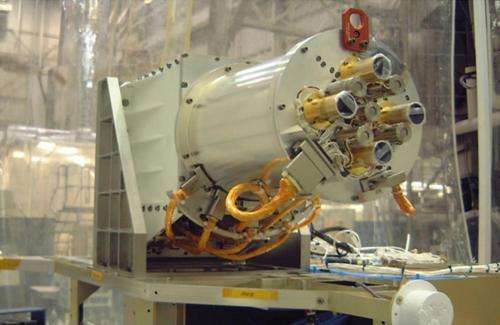NOAA's DSCOVR NISTAR instrument watches Earth's 'budget'

The NISTAR instrument that will fly aboard NOAA's space weather-observing spacecraft called the Deep Space Climate Observatory (DSCOVR), is going to measure the Earth's radiation budget.
NASA is flying two Earth science instruments aboard NOAA's DSCOVR spacecraft. One of them is called the National Institute of Standards and Technology Advanced Radiometer or NISTAR. Basically, NISTAR measures the absolute irradiance over a broad spectrum of the entire sunlit face of Earth. That will tell the instrument Earth's radiation budget, i.e. if the Earth's atmosphere is retaining more or less solar energy than it radiates back to space.
If Earth is keeping in more solar energy than it expels, then the Earth will warm. If the Earth and the Earth-system radiates more energy to space than it receives from the sun, the Earth will cool. Absorbed sunlight raises the Earth's temperature. Emitted radiation or heat lowers the temperature. When absorbed sunlight and emitted heat balance each other, the Earth's temperature doesn't change - the radiation budget is in balance.
NISTAR is an active cavity radiometer designed to measure the energy reflected and emitted from the entire sunlit face of the Earth from its orbit around the Lagrangian point 1 (L1). L1 is a neutral gravity point between Earth and the sun. This position offers a unique continuous view of the Earth at noon.
This measurement will improve our understanding of the effects of changes to Earth's reflected and emitted radiation (radiance) caused by human activities and natural phenomena. This information can be used for climate science applications.
The term Active Cavity Radiometer (ACR) was assigned by its inventor, Dr. Richard C. Willson of Columbia University, and earlier generations of the ACR were flown on the Solar Max and ACRIM (Active Cavity Radiometer Irradiance Monitor) missions. "NISTAR is unique in that instead of measuring the sun's radiation and variability, it is measuring the Earth's,"said Mark LaPole, Director of Space Products, Ball Aerospace, Boulder, Colorado. "The accuracy requirements were developed by the NISTAR Principal Investigators, Dr. Steven R. Lorentz and Dr. Joseph P. Rice of NIST."
NISTAR was designed and built between 1999 and 2001 by Ball Aerospace and Technology Corporation working with the National Institute of Standards and Technology (NIST), Gaithersburg, Maryland and the Scripps Institution of Oceanography who developed the Scripps-NIST advanced radiometer, or Scripps NISTAR instrument.
"NISTAR uses active cavity radiometers, that absorb all of the incident radiation in internal cavities and monitors the heater currents necessary to maintain the cavity at a constant measured temperature, thus determining the incident energy," said Adam Szabo, DSCOVR Project Scientist at NASA's Goddard Space Flight Center in Greenbelt, Maryland. "Recent ground recalibration of this instrument indicate that better than the required 1% absolute accuracy will be achieved."
"NIST will be able to separate the Earth radiant power from reflected solar energy by making measurements in three overlapping wavelength bands. This will be an important contribution to the Earth climate debate," Szabo said.
The radiometer is based on the NIST electrical-substitution measurement approach and Ball modular instrument electronics technology from the Spitzer and CALIPSO missions. Ball performed the instrument system engineering, and designed, fabricated, and tested the NISTAR payload. NISTAR was calibrated at the world-class NIST SIRCUS (Spectral irradiance and radiance responsivity calibrations using uniform sources) facility.
Ball also provided DSCOVR with the CT633 star tracker and attitude sensor. In preparation for the mission, the sensor was recalibrated, and outfitted with an improved lightshade and software. Final verification included solar testing in the Ball Stray Light Facility.
NOAA's Deep Space Climate Observatory (DSCOVR), will give forecasters more reliable measurements of solar wind speed, density, and temperature, improving their ability to monitor harmful solar activity, and replace an aging research satellite currently used to warn of impacts to Earth.
More information: www.nesdis.noaa.gov/DSCOVR/
Provided by NASA's Goddard Space Flight Center





















